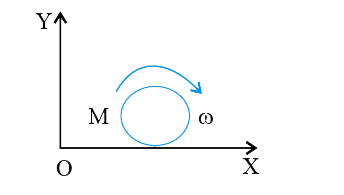A disc of mass M kg and radius R metre is rotating at an angular speed of rad/s when the motor is switched off. Neglecting the friction at the axie, the force that must be applied tangentially to the wheel to bring it to rest time t is
The correct Answer is:A
To solve the problem of determining the force that must be applied tangentially to a rotating disc to bring it to rest in a given time t, we can follow these steps:
1. Identify the Initial Conditions:
- The disc has a mass M and radius R.
- It is rotating with an initial angular speed ω (in radians per second).
2. Calculate the Moment of Inertia:
- The moment of inertia I of a solid disc about its central axis is given by the formula:
I=12MR2
3. Determine the Initial Angular Momentum:
- The initial angular momentum Li of the disc can be calculated using:
Li=I⋅ω=12MR2⋅ω
4. Final Angular Momentum:
- The final angular momentum Lf when the disc comes to rest is:
Lf=0
5. Calculate the Change in Angular Momentum:
- The change in angular momentum ΔL is:
ΔL=Lf−Li=0−12MR2ω=−12MR2ω
6. Relate Torque to Change in Angular Momentum:
- The torque τ applied to the disc is related to the change in angular momentum over time t:
τ=ΔLΔt=−12MR2ωt
7. Express Torque in Terms of Force:
- The torque can also be expressed as:
τ=R⋅F
- Where F is the tangential force applied.
8. Set the Two Expressions for Torque Equal:
- Equating the two expressions for torque gives:
R⋅F=−12MR2ωt
9. Solve for the Force F:
- Rearranging the equation to solve for F:
F=−12MRωt
- The negative sign indicates that the force is applied in the opposite direction of the rotation.
10. Final Expression for the Force:
- The magnitude of the force required to bring the disc to rest in time t is:
F=MRω2t
Summary:
The force that must be applied tangentially to the wheel to bring it to rest in time t is given by:
F=MRω2t
- The disc has a mass M and radius R.
- It is rotating with an initial angular speed ω (in radians per second).
- The moment of inertia I of a solid disc about its central axis is given by the formula:
I=12MR2
- The initial angular momentum Li of the disc can be calculated using:
Li=I⋅ω=12MR2⋅ω
- The final angular momentum Lf when the disc comes to rest is:
Lf=0
- The change in angular momentum ΔL is:
ΔL=Lf−Li=0−12MR2ω=−12MR2ω
- The torque τ applied to the disc is related to the change in angular momentum over time t:
τ=ΔLΔt=−12MR2ωt
- The torque can also be expressed as:
τ=R⋅F
- Where F is the tangential force applied.
- Equating the two expressions for torque gives:
R⋅F=−12MR2ωt
- Rearranging the equation to solve for F:
F=−12MRωt
- The negative sign indicates that the force is applied in the opposite direction of the rotation.
- The magnitude of the force required to bring the disc to rest in time t is:
F=MRω2t
The force that must be applied tangentially to the wheel to bring it to rest in time t is given by:
F=MRω2t
Similar Questions
A wheel of mass 10 kg and radius 0.2 m is rotating at an angular speed of 100 rpm, when the motion is turned off. Neglecting the friction at the axis. Calculate the force that must be applied tangentially to the wheel to bring it to rest in 10 rev. Assumed wheel to be a disc.
View SolutionA wheel of mass 10 kg and radius 0.2 m is rotating at an angular speed of 100 rpm, when the motion is turned off. Neglecting the friction at the axis. Calculate the force that must be applied tangentially to the wheel to bring it to rest in 10 rev. Assumed wheel to be a disc.
View Solution
Knowledge Check
- Question 1 - Select One
A disc of mass 1 kg and radius 10 cm is rotating about its axis with an anuglar velocity of 2 rad/s. The linear momentum of the disc,
A0.2 kg-m/sBzeroC0.4 kg-m/sD0.02 kg-m/s - Question 2 - Select One
A whel of mass 2kg an radius 10 cm is rotating about its axis at an angular velocity of 2πrad/s the force that must be applied tangentially to the wheel to stop it in 5 revolutions is
A3π×10−2kg−m2/sB4π×10−2kg−m2/sCπ×10−2kg−m2/sD2π×10−2kg−m2/s - Question 3 - Select One
A homogeneous disc of mass 2 kg and radius 15 cm is rotating about its axis with an angular velocity of 4 rad/s. the linear momentum of the disc is
A1.2 kg m/sB1.0 kg m/sC0.6 kg m/sDzero
A pulley in the form of solid disc of mass 5kg and radius 1m is rotating at an angular speed of 120 rpm when the motor is turned off, Neglecting the friction at the axle, calculate the force that must by applied tangentially to the pulley to bring it to rest in 4 revolutions.
View SolutionA disc of mass m and radius R rotating with angular speed ω0 is placed on a rough surface (co-officient of friction =μ). Then
 View Solution
View SolutionA disc of mass M and Radius R is rolling with an angular speed ω on the horizontal plane. The magnitude of angular momentum of the disc about origin is:
 View Solution
View SolutionA disc of mass M and radius R is rolling with angular speed w on horizontal plane as shown. The magnitude of angular momentum of the disc about the origin O is :
 View Solution
View Solutiona body of mass 10 kg and radius of gyration 0.1 m is rotating about an axis. If angular speed is 10 rad/s, then angular momentum will be:
View Solution

